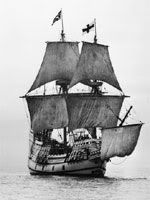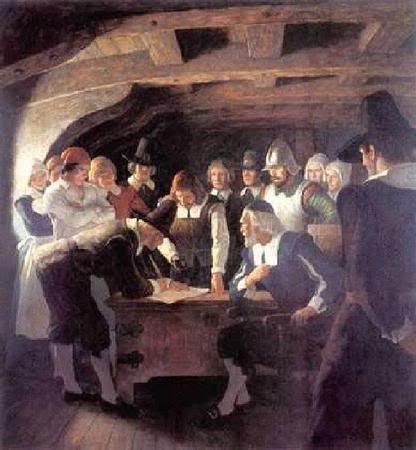Maine
Maine consists largely of a coastal plain of eroded valleys, with more resistant rock forming the generally mountainous west. Mt. Katahdin (5,268 ft/1,606 m) is the highest point in the state. Ninety percent of the land is forest including great stands of white pine, hemlock, spruce, fir, and hardwoods, which would inhibit population later. Caused by receding glaciers, there are more than 2200 lakes and more than 5000 streams and rivers. The coast is filled with jagged rocks and cliffs and thousands of bays and inlets. The major rivers include the St. John, the Penobscot, the Kennebec, the Androscoggin, and the Saco.
Connecticut
The highest peak in Connecticut is Bear Mountain in Salisbury in the northwest corner of the state, however, it is not the highest point. The state, although small, has regional variations in its landscape and culture from Fairfield County's to the rolling mountains and farms of the Litchfield Hills and Southeastern Connecticut. The Connecticut River, which flows through only the northern half of this lowland, veers off to the southeast in central Connecticut. In the south along Long Island Sound is a low, rolling coastal plain. The western highland, with the Taconic Mts. and the Litchfield Hills, is more rugged than the eastern highland.
Massachusetts
The eastern part Massachusetts, including the Cape Cod peninsula and the islands lying off it to the south—the Elizabeth Islands, Martha's Vineyard, and Nantucket—is a low coastal plain. In the interior rise uplands separated by the rich Connecticut River valley, and farther west lays the Berkshire valley, surrounded by the Berkshire Hills, part of the Taconic Mts. Mt. Greylock in the Berkshires is the highest point (3,491 ft/1,064 m).
New Hampshire
New Hampshire's major regions are the Great North Woods, the White Mountains, the Lakes Region the Seacoast, the Merrimack Valley, the Monadnock Region, and the Dartmouth-Lake Sunapee area. The White Mountains range in New Hampshire spans the north-central portion of the state, with Mount Washington being the tallest in New England, and other mountains like Mount Madison and Mount Quincy Adams surrounding it. Major rivers include the 110-mile Merrimack River, which bisects the lower half of the state north-south and ends up in Massachusetts
Rhode Island
The mean elevation of the state is 200 ft. Narragansett Bay is a major feature of the state's topography. Block Island, known for its beaches, lies approximately 12 miles off the southern coast of the mainland. Within the Bay, there are over 30 islands the largest being Aquidneck Island. Rhode Island's highest natural point is Jerimoth Hill, only 812 feet (247 m) above sea level.
Vermont
The west bank of the Connecticut River marks the eastern border of the state with New Hampshire (the river itself is part of New Hampshire). Lake Champlain is the major lake in Vermont while Mount Mansfield is the highest mountain in the state.
New York
New York’s border touch two Great Lakes, the Eire and Ontario. The Hudson River begins with Lake Tear of the Clouds and flows south through the eastern part of the state without draining Lakes George or Champlain. Lake George empties at its north end into Lake Champlain, whose northern end extends into Canada, where it drains into the Richelieu and then the St Lawrence Rivers. Mt. Marcy (5,344 ft/1,629 m), the highest point in the state, is near Lake Placid. Most of the southern part of the state is on the Allegheny plateau, which rises in the SE to the Catskill Mts.
New Jersey
New Jersey is surrounded by water except along the 50 mi (80 km) of northern border with New York State. The northern third of the state lies within the Appalachian Highland region, where ridges running northeast and southwest shelter valleys containing pleasant streams and glacial lakes. The Kittatinny Mts., with the state's highest elevations (up to 1,803 ft/550 m), stretches across the northwest corner of New Jersey from the New York border to the Delaware Water Gap. Southeast of the Highlands lie the Triassic lowlands or piedmont plains. . Offshore barrier islands make large harbors impractical but provide 115 mi (185 km) of sheltered waterways that have made possible a superior combination of bay and ocean facilities. Inland from the coast laid the Pine Barrens, a vast area of forests, small rivers, and few settlements.
New Brunswick
New Brunswick is bounded on the north by Quebec's Gaspé Peninsula and Chaleur Bay and on the east by the Gulf of Saint Lawrence and Northumberland Strait. To the south, the narrow Isthmus of Chignecto connects it to peninsular Nova Scotia, most of which is separated from the mainland by the Bay of Fundy. There are several major river systems in the province including the St. John River, Petitcodiac River, Miramichi River, St. Croix River and the Restigouche River.
Nova Scotia
The province's mainland is a peninsula, connected to mainland North America by the Isthmus of Chignecto, and surrounded by the Atlantic Ocean, including numerous bays and estuaries. Rivers include the Magaree River, the Aspy River, Mira River, and the Noel River.
Prince Edwards Island
The island is located in the Gulf of Saint Lawrence, east of New Brunswick and north of Nova Scotia from which it is separated by the Northumberland Strait. The coastline of the island consists of a combination of long beaches, dunes, short sandstone cliffs, salt water marshes and numerous small bays and harbors. Large dune fields on the north shore can be found on barrier islands at the entrances to various bays and harbors.













